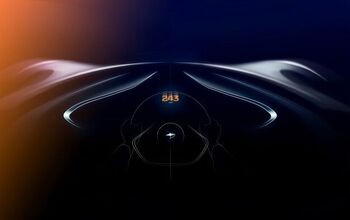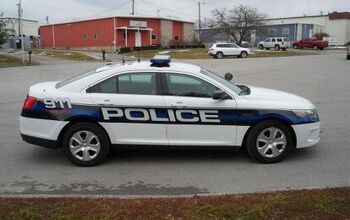The Fastest Cop Car is Not a Car
In September of last year, the Michigan State Police conducted their 2019 Model Year Police Vehicle Evaluations. The purpose of these tests is to provide objective performance data to the individual agencies who are making purchasing decisions for their divisions.
For the automakers, it’s an all-out race for pride in being the superior bad-guy chaser. Ford hands off the title from their own 2018 3.5-liter EcoBoost Police Interceptor AWD (Taurus) sedan to their 2019 Police Interceptor Utility 3.0L EcoBoost AWD Explorer SUV.
It’s a first that an SUV has been fastest in the Police Vehicle Evaluations, but it reflects the change in market preference for SUVs over sedans. Part of the justification was – and is, for many agencies – that high-speed pursuit is unnecessary with the tracking capability that is in use today. For those that need it, Ford has taken their new rear-wheel-drive-based Explorer and provided a package that tops the performance charts while providing all the flexibility of an SUV package.
The Police Interceptor Utility 3.0L EcoBoost AWD Explorer SUV puts out 400 horsepower and 415 lb-ft of torque from its twin-turbo V6. Transferred through a 10-speed automatic transmission and to all four wheels, the Explorer was over a second faster to 100 mph than the V8-powered Chargers, taking 13.59 seconds. Not that it’s practically usable in the real world, but top speed just edged the Chargers by 1 mph, hitting 150 mph.
In dynamics testing at Grattan Raceway, the EcoBoost Explorer averaged 1:36.47, beating out the Dodge Charger 5.7L AWD by 0.63 seconds. Dodge also brought Pursuit Durangos to the party, which lapped in an average of 1:42.70 in 5.7L trim. Ford’s additional two Explorer models were both handily faster around the road course, though. The 3.3L naturally-aspirated V6 Explorer posted a 1:39.96 average, while the Hybrid model did even better, with a 1:39.73.
Complete test results are available from the State of Michigan HERE.
It should be noted that this performance doesn’t come cheap, though. The 3.3-liter V6 model starts at $37,500, the hybrid at $41,000, and $42,000 for the 3.0L turbo, though fleet prices may vary. Pricing for the Charger ranges from $32,325 for the V6 RWD to $36,750 for the V8 AWD, while the Chevrolet Tahoe PPV 5.3-liter RWD stars at $42,765.
Now, as a bit of background, I have some first-hand knowledge of this process. I was formerly a Vehicle Dynamics Performance Engineer at FCA and worked on evaluation and development of pursuit models. What makes a pursuit model so is really based on the manufacturer’s definition. There are a myriad of pursuit-specific durability, functionality, and load-carrying requirements. But, from the 2019 MY MSP Police Evaluation Test Book, they state,
“The manufacturers provide upcoming model year vehicles to both the MSP and Los Angeles County Sheriff’s Department to be tested for suitability in their respective operations. Historically, successful results at both test sites have validated the manufacturers’ engineering efforts in building a car capable of handling the stress associated with police pursuits. Neither the MSP, nor the Los Angeles County Sheriff’s Department, has the authority or credentials to award the term pursuit rated to any vehicle.
The MSP has performance criteria attached to its purchasing specifications. The criteria has historically been that a vehicle must accelerate from 0 – 60 mph in 9.0 seconds, 0 – 80 mph in 14.9 seconds, and 0 – 100 mph in 24.6 seconds. The vehicle must reach 110 mph in 4,838 feet and 120 mph in 8,985 feet. The vehicle must maintain an average deceleration rate of 25.79 ft./sec2 while performing twenty 60 – 0 mph threshold braking stops. The vehicle must also successfully complete all 32 laps of the Grattan Raceway dynamics testing without major component failure. Meeting these criteria does not certify a vehicle as being pursuit rated, rather it justifies a vehicle is capable of performing the job function the MSP requires in a police vehicle.”
The objective acceleration, braking, and top speed tests are conducted at FCA’s Chelsea Proving Grounds in Michigan, where I used to work, while the dynamics testing is conducted at Grattan Raceway in Belding, MI. The L.A. County Sheriff’s Department conducts a similar test on an infield road course at Auto Club Speedway in Fontana, CA. I’ve been a part of multiple evaluations at both locations and can attest to the unique set of challenges that each test brings.
The highlight of the evaluations are certainly the dynamics testing. Each manufacturer spends considerable effort preparing their vehicles to survive the rigors of the 32-lap racetrack evaluation. Each vehicle is driven for eight laps by four separate drivers, with only 5 minutes of pause between evaluations. The five fastest laps for each driver are combined and averaged to provide a final score.
Before you think that these are beginner HPDE-style laps, believe me, they are not. The MSP and LACSD have a skilled set of drivers on hand. The lap times posted for all drivers were within 2-4 seconds of what this FIA Silver-rated driver could do. And that is without the benefit of having the intimate familiarity of how to get the most out of each particular car.
The evaluations are run with the cars in their default modes of electronic stability control on and the transmission in drive. No ESC deactivation or manual shifting is allowed, even if it’s available on the car. Therefore, a significant part of the racetrack performance comes down to calibration of the transmission and ESC.
If you’ve ever forgotten to deactivate a default ESC mode when on track or autocross, you know how restricting they can be. The baseline ESC calibrations end up being more like what you’d find in a sport mode of a performance street car. Based on the way one is driving, such as extended wide-open throttle, most of the vehicles will automatically convert to an aggressive powertrain strategy. They would maintain the lowest gear possible for maximum acceleration coming out of a corner, until extended coasting was detected. With 10 gear ratios to choose from, the Fords are likely realizing a significant performance benefit over the five-speeds that are carrying on in the Chargers.
While the going and turning is a big part of putting together a good lap time, one of the most difficult aspects to manage is braking performance. Thirty-two near-consecutive hot laps, with no mercy being offered to the brakes, takes significant engineering development to withstand. Pad materials are a science of their own. But, since there are so many systems competing for space and thermal expulsion, force-fed cooling is typically not an option. Air may be routed into the inner wheel well, but massive brakes are fitted to simply act as a heat sink to keep the fluid from boiling.
Lastly, it should be kept in mind that all the forces acting on these police package vehicles are being done so through all-season tires. They must survive the 32-lap flogging without chunking or delaminating, which is a tall order for these heavy vehicles that are not optimally set up for racetrack duty. The fact that so many are turning sub-1:40 lap times at Grattan Raceway should make you think twice before you try to outrun one. Speed and radios aside, chances are good that they’ll survive typical road hazards that would disable most quicker vehicles.
Now, if only FCA will bring their Redeye-powered Durango SRT Pursuit “Speed Trap” Concept to the 2020 Model Year Trials, the crown for fastest police package SUV just might change hands.
[Images: Ford, Michigan State Police, FCA]
Following 10 years in Toyota's Production Engineering division, Anthony spent 3 years as a Vehicle Dynamics Engineer for FCA. From modest beginnings in autocross, he won a NASA SpecE30 National Championship and was the 2017 Pirelli World Challenge TC Rookie of the Year. Aside from being a professional racecar driver, he is a private driving coach and future karaoke champion.
More by Anthony Magagnoli
Latest Car Reviews
Read moreLatest Product Reviews
Read moreRecent Comments
- Doug brockman There will be many many people living in apartments without dedicated charging facilities in future who will need personal vehicles to get to work and school and for whom mass transit will be an annoying inconvenience
- Jeff Self driving cars are not ready for prime time.
- Lichtronamo Watch as the non-us based automakers shift more production to Mexico in the future.
- 28-Cars-Later " Electrek recently dug around in Tesla’s online parts catalog and found that the windshield costs a whopping $1,900 to replace.To be fair, that’s around what a Mercedes S-Class or Rivian windshield costs, but the Tesla’s glass is unique because of its shape. It’s also worth noting that most insurance plans have glass replacement options that can make the repair a low- or zero-cost issue. "Now I understand why my insurance is so high despite no claims for years and about 7,500 annual miles between three cars.
- AMcA My theory is that that when the Big 3 gave away the store to the UAW in the last contract, there was a side deal in which the UAW promised to go after the non-organized transplant plants. Even the UAW understands that if the wage differential gets too high it's gonna kill the golden goose.







































Comments
Join the conversation
In HNL, I would guess 50-percent of the police cars are Tauri or Explorer --HPD bought a bunch in recent years, with the occasional Fusion Hybrid or Crown Vic still hanging around*-- while 50-percent are subsidized, unmarked (except for the light bar) civilian cars, the Toyota 4Runner very popular among the cops. I'm guessing HPD has access to the MSP/LA test results, but that obviously didn't resonate with the cops when buying their personal rides. *I've seen exactly one Toyota Camry and one Dodge Charger in HPD blue. Must have been an experiment.
https://www.tirerack.com/tires/tires.jsp?tireMake=Firestone&tireModel=Firehawk+GT+Pursuit&sidewall=Blackwall&partnum=455WR8FHGTP&tab=Sizes In case anyone wants those magic all season tires. $372.21 a piece from the Tire Rack. Taxpayers take note.